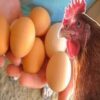The Maize/Corn Stigma is a small, sticky structure that protrudes from the tip of the silk, which is part of the female inflorescence, or ear. Its sticky surface is covered with fine hairs and a viscous secretion known as the stigma exudate. This sticky substance serves to capture and retain pollen grains when they come into contact with the stigma.
Pollination in maize occurs through the transfer of pollen from the male reproductive organs, known as the tassel, to the female reproductive organs, including the stigma. This transfer of pollen can occur through various means, including wind dispersal or insect-mediated pollination. When a pollen grain lands on the stigma, it adheres to the sticky surface, allowing the pollen tube to germinate and penetrate the stigma’s tissues.
Once the pollen tube penetrates the stigma, it elongates and grows downward through the style, which is the stalk-like structure that connects the stigma to the ovary. The ovary contains ovules, which are potential seeds, and the fertilization process occurs when the pollen tube reaches an ovule and delivers sperm cells for fertilization.
The structure and function of the maize stigma are finely tuned to maximize the chances of successful pollination and fertilization. Its sticky surface and hair-like structures increase the likelihood of pollen capture, while its position at the tip of the silk ensures exposure to incoming pollen grains.
Environmental factors such as temperature, humidity, and wind speed can influence the efficiency of pollination and stigma receptivity. Optimal conditions, including moderate temperatures and low wind speeds, can enhance pollen germination and stigma function, leading to higher fertilization rates and improved crop yields.
Maize farmers often monitor the development of the stigma and silk closely to determine the optimal timing for pollination. This timing is critical for ensuring that the stigma is receptive when pollen is available, maximizing the chances of successful fertilization and kernel development.
In conclusion, the maize stigma plays a crucial role in the reproductive process of maize plants. Its sticky surface and hair-like structures facilitate pollen capture, while its position at the tip of the silk ensures exposure to incoming pollen grains. Understanding the biology of the maize stigma is essential for optimizing pollination and maximizing crop yields in maize production.
The Economic Importance and Uses of Maize/Corn Stigma

1. Pollination: Maize stigma plays a crucial role in pollination, facilitating the transfer of pollen from the male reproductive organs to the female reproductive organs, ultimately leading to fertilization and seed production.
2. Crop Yield: Efficient pollination facilitated by the maize stigma contributes to higher crop yields by ensuring successful fertilization and kernel development.
3. Hybrid Seed Production: Maize stigma is essential in hybrid seed production, where specific varieties are cross-pollinated to produce seeds with desirable traits such as disease resistance or higher yield potential.
4. Genetic Research: Maize stigma provides valuable genetic material for research purposes, allowing scientists to study traits related to pollination efficiency and fertility.
5. Plant Breeding: Maize stigma is utilized in plant breeding programs to develop improved varieties with traits such as drought tolerance, pest resistance, or enhanced nutritional content.
6. Biotechnology: Maize stigma may have applications in biotechnological research, including genetic engineering for trait improvement or pharmaceutical production.
7. Agriculture: Maize stigma contributes to the agricultural sector by supporting maize production, which serves as a staple food and feed crop worldwide.
8. Food Industry: Maize stigma indirectly benefits the food industry by ensuring the availability of maize grains for various food products such as cornmeal, cornflakes, and corn syrup.
9. Livestock Feed: Maize stigma is used as a component of livestock feed, providing essential nutrients for animals such as cattle, poultry, and swine.
10. Ethanol Production: Maize stigma can be utilized in ethanol production, as maize grains are a common feedstock for biofuel production.
11. Pharmaceutical Industry: Extracts derived from maize stigma may have potential pharmaceutical applications, including the extraction of bioactive compounds or the production of medicinal products.
12. Textile Industry: Maize stigma can be used in the textile industry for the production of bio-based fibers or materials.
13. Cosmetic Industry: Extracts derived from maize stigma may find applications in the cosmetic industry for skincare or haircare products.
14. Paper Industry: Maize stigma can be utilized in the papermaking process to produce paper products or packaging materials.
15. Environmental Remediation: Maize stigma may play a role in environmental remediation efforts, such as phytoremediation, by assisting in the removal of pollutants from soil or water.
16. Soil Health: Maize stigma contributes to soil health by supporting crop rotation practices and organic matter decomposition.
17. Cultural and Traditional Uses: Maize stigma holds cultural significance in many societies and may be used in traditional ceremonies or rituals.
18. Economic Stability: The cultivation and utilization of maize stigma contribute to economic stability by providing employment opportunities and supporting rural livelihoods in maize-growing regions.
Read Also General Features of Ruminant Animals
The Products and By-products That Can Be Derived From Maize/Corn Stigma

1. Pollen: Maize stigma facilitates the capture of pollen, which is essential for fertilization and seed production.
2. Hybrid Seeds: Maize stigma is crucial in hybrid seed production, leading to the development of seeds with desirable traits.
3. Genetic Material: Maize stigma provides genetic material for research purposes, aiding in genetic studies and breeding programs.
4. Biofuel Feedstock: Maize stigma contributes to biofuel production by providing feedstock for ethanol production.
5. Animal Feed: Maize stigma can be utilized as a component of animal feed, providing essential nutrients for livestock.
6. Biodegradable Materials: Maize stigma may be used in the production of biodegradable plastics or packaging materials.
7. Nutritional Supplements: Extracts from maize stigma may be used as nutritional supplements due to their potential health benefits.
8. Medicinal Products: Maize stigma extracts may have pharmaceutical applications, including the production of medicinal products.
9. Textile Fibers: Maize stigma can be processed to produce bio-based fibers for textiles or materials.
10. Paper Products: Maize stigma may be used in the papermaking process to produce paper products or packaging materials.
11. Bio-based Chemicals: Maize stigma can be utilized in the production of bio-based chemicals such as ethanol or organic acids.
12. Soil Amendments: Maize stigma may be composted and used as soil amendments to improve soil structure and fertility.
13. Fertilizers: Composted maize stigma can serve as organic fertilizers, providing essential nutrients for plant growth.
14. Animal Bedding: Maize stigma can be used as animal bedding material for livestock such as poultry or small mammals.
15. Green Energy: Maize stigma contributes to the production of green energy through biofuel production and biogas generation.
16. Cultural and Traditional Crafts: Maize stigma may be used in cultural or traditional crafts, such as decorative items or artwork.
Read Also Feeding Materials for Ruminant Animals
Frequently Asked Questions (FAQ’s) About Maize/Corn Stigma

1. What is the role of maize stigma in pollination?
Maize stigma facilitates the capture of pollen, which is essential for fertilization and seed production.
2. How does maize stigma contribute to hybrid seed production?
Maize stigma is crucial in hybrid seed production, leading to the development of seeds with desirable traits through cross-pollination.
3. Can maize stigma be used in genetic research?
Yes, maize stigma provides valuable genetic material for research purposes, aiding in genetic studies and breeding programs.
4. What environmental benefits does maize stigma provide?
Maize stigma contributes to environmental remediation efforts and soil health through organic matter decomposition and phytoremediation.
5. Are there any industrial applications of maize stigma?
Yes, maize stigma has various industrial applications, including biofuel production, pharmaceuticals, and textile manufacturing.
6. How does maize stigma contribute to agricultural sustainability?
Maize stigma supports sustainable agriculture by enhancing crop yields, improving soil health, and providing economic opportunities for farmers.
7. Can maize stigma be used in alternative energy production?
Yes, maize stigma contributes to alternative energy production through biofuel production and biogas generation.
8. What role does maize stigma play in cultural traditions?
Maize stigma holds cultural significance in many societies and may be used in traditional ceremonies or rituals.
9. Are there any emerging technologies utilizing maize stigma?
Emerging technologies may utilize maize stigma in biotechnological applications, such as genetic engineering or pharmaceutical production.
10. How does maize stigma contribute to economic stability?
The cultivation and utilization of maize stigma provide employment opportunities and support rural livelihoods in maize-growing regions, contributing to economic stability.
Read Also Low-Maintenance Plants for Beginners






